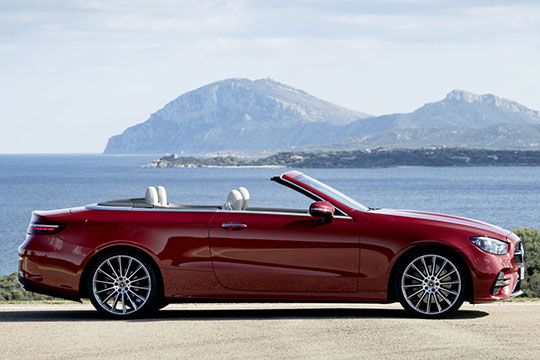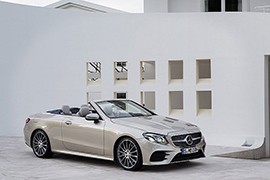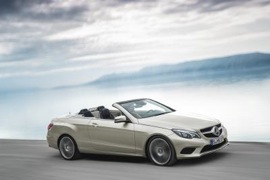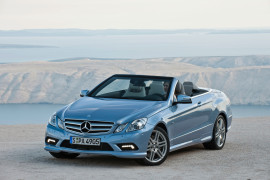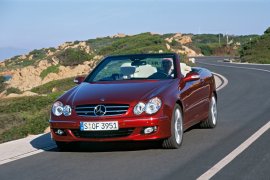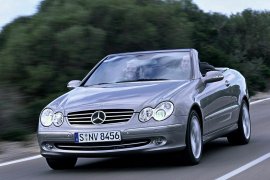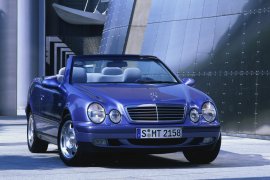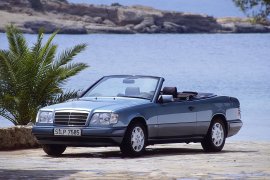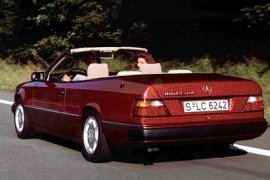MERCEDES BENZ E-Klasse Cabriolet and predecessors Models/Series Timeline, Specifications & Photos
First production year: 1992
Engines: Mild hybrid, Diesel, Gasoline
Body style: Convertible (spider/spyder, cabrio/cabriolet, drop/open/soft top)
When the E-Class coupe lost its head and placed a canvas-top, it became an E-Class convertible, one of the sexiest cars in the executive-car category.
Ever since 1953, before even the E-Class had that name, the luxurious Mercedes-Benz range was well received by the market. Each time a new generation was introduced, it was a benchmark for its class. The first generation to receive the E-Class badge was the facelifted, 1993, W124 model. The 2020 model was the facelifted version for the fifth generation, which stormed the showrooms in 2017.
Mercedes-Benz introduced the facelift in 2020 with a new set of LED headlights and flatter housings. The diamond-style, 3D design of the grille was enhanced, and the A-shaped lower grille design of the apron amplified the dynamic style. Two powerdomes on the hood evoked a V engine, even if some models received inline-four units. The new LED taillights design and the chromed splitter made the car looks sportier. The canvas-top remained unchanged.
The interior received a new technological update for the infotainment unit with the MBUX system. It was fitted with two 10.25" screens arranged side by side under the same glass-panel. There was an even bigger, 2x12.3" screen option. The new steering wheel with capacitive touch-areas to control various systems installed on the car enhanced the driving experience.
To lower the emissions, the four-cylinder engine received an integrated starter-generator (ISG) and a 48v architecture. A recuperation function and the ability to "glide" with the engine switched off made the engine even more efficient. The electrification continued on all the gasoline engines as well, and the only gearbox available for the entire range was the 9G-Tronic (dual-clutch) automatic.
The 2016 Mercedes-Benz E-Class Cabriolet was the open-top version of a two-door car based on a four-door sedan and it offered truly four seats.
The recipe was simple and it was used since mid-2000. Then, the CLK cabriolet was built on a W203 C-Class chassis, with styling from the E-Class. As the time went by, the following generation of the CLK kept the same recipe (and same W203 chassis) but without the E-Class elements for the outside. Only some interior elements were taken. After that, the Mercedes-Benz decided to build the E-Class cabriolet, based also on a C-Class platform.
The styling was from the E-Class coupe, which was a normal thing to do. The E-Class coupe was one of the most beautiful vehicles in its class, at the time of launch in late 2016. The exterior look was complemented by LED headlights and slightly sculpted door panels. It didn't feature the muscular shoulders on the rear fenders as before. This transformed the car into more of a luxury cruiser instead of a sporty open-top vehicle.
Inside, the luxury was the key element. The new dashboard with big screens instead of an instrument cluster with analog dials plus an infotainment unit brought a modern look for the car. Like its predecessor, the 2016 E-Class Cabriolet offered four seats inside, with the air-cap system on top of the windshield to allow open-top cruising without damaging the hair-style of the rear passengers.
Under the hood, the car-manufacturer installed both diesel and gasoline engines. While some are considering that a diesel engine was not proper for a convertible, others just liked the range and better fuel-efficiency.
MERCEDES BENZ E-Class Cabriolet (A238) E 200 4MATIC (184 HP)
MERCEDES BENZ E-Class Cabriolet (A238) E 200 9AT (184 HP)
MERCEDES BENZ E-Class Cabriolet (A238) E 300 9AT (245 HP)
MERCEDES BENZ E-Class Cabriolet (A238) E 350 9AT (300 HP)
MERCEDES BENZ E-Class Cabriolet (A238) E 400 4MATIC 9AT (333 HP)
Mercedes-Benz refreshed the E-Class Coupe and Cabriolet in 2013 after, just four years since it introduced the model in its lineup.
When it made the facelift for the C207/A207 models, the German automaker upgraded the front facia and the engine lineup. In addition, it made them compliant with the Euro6 standards, which became mandatory in September 2014 in the European Union. At the same time, it also fixed the problems that it had with the 1.8-liter supercharged engines. The result was appreciated even more by customers since the new version featured a new interior.
Like the rest of the E-Class range, the open-top version lost the quad-headlight setup and gained two headlights with an organic, fluid shape. Depending on the trim level and options, the car sported a more aggressive front bumper with an A-shaped lower grille, introduced as the AMG package. Furthermore, the side scoops hosted the LED daytime running lights. From its profile, the overall look remained the same, but at the rear, there were new LED taillights.
While many people asked for a refreshed exterior, few had expected the interior upgrades where Mercedes-Benz completely changed the cabin. It moved the gear selector behind the steering wheel, leaving the center console clear, thus creating more storage areas. Atop the center stack, the automaker integrated the infotainment screen neatly under the same cover as the instrument panel.
Along with the facelift, the previously used 1.8-liter supercharged versions were removed, and the automaker added a 2.0-liter gasoline engine as the base version. In addition, it improved the performance of the turbo-diesel powerplants.
MERCEDES BENZ E-Klasse Cabriolet (A207) E 200 6MT RWD (184 HP)
MERCEDES BENZ E-Klasse Cabriolet (A207) E 200 7AT RWD (184 HP)
MERCEDES BENZ E-Klasse Cabriolet (A207) E 250 7AT RWD (211 HP)
MERCEDES BENZ E-Klasse Cabriolet (A207) E 300 7AT RWD (252 HP)
MERCEDES BENZ E-Klasse Cabriolet (A207) E 350 7AT RWD (306 HP)
MERCEDES BENZ E-Klasse Cabriolet (A207) E 400 7AT RWD (333 HP)
MERCEDES BENZ E-Klasse Cabriolet (A207) E 500 7AT RWD (408 HP)
MERCEDES BENZ E-Klasse Cabriolet (A207) E 550 7AT RWD (402 HP)
MERCEDES BENZ E-Klasse Cabriolet (A207) E 220 CDI 6MT RWD (170 HP)
MERCEDES BENZ E-Klasse Cabriolet (A207) E 220 CDI 7AT RWD (170 HP)
MERCEDES BENZ E-Klasse Cabriolet (A207) E 250 CDI 6MT RWD (204 HP)
MERCEDES BENZ E-Klasse Cabriolet (A207) E 250 CDI 7MT RWD (204 HP)
MERCEDES BENZ E-Klasse Cabriolet (A207) E 350 BlueTEC 7AT RWD (252 HP)
The Mercedes-Benz E-Class Cabriolet was introduced in 2009, as the last body version for the E-Class. It was the fourth model in the family, after the sedan, station-wagon, and the coupe.
After two generations for the CLK, a model that was based on the C-Class with E-Class styling, the Mercedes-Benz decided to launch a proper E-Class convertible based on a proper E-Class coupe. And the features of the E-Class Cabriolet were among the top in its class.
The styling of the E-Class coupe was carried over to the open-top version. The sharp headlights, raked A-pillars and rear shoulders over the fenders were styling elements that were appreciated by the customers. The whole car looked classy, yet modern.
Inside, the E-Class Cabriolet featured unique features for its class. Besides the heated seats it had the "Air-scarf" innovation. Warm air was blown on the front-seats occupant's necks so they won't feel the cold air. Another innovation was the Air-cap system. As soon as the rear passengers were placing their seatbelts on, a wind deflector popped out from the top of the windshield and the air was diverted behind the cabin. At the same time, a pop-up wind-deflector appeared behind the rear seats.
For the engine compartment, Mercedes-Benz installed various engines, including turbodiesel versions. That was hard to accept by conservative convertible users. But the vehicle was very fuel-efficient and its performance was decent.
MERCEDES BENZ E-Klasse Cabriolet (A207) 200 CGI 6MT (181 HP)
MERCEDES BENZ E-Klasse Cabriolet (A207) 250 CGI 5AT (201 HP)
MERCEDES BENZ E-Klasse Cabriolet (A207) 300 BlueEFICIENCY 7AT (252 HP)
MERCEDES BENZ E-Klasse Cabriolet (A207) 350 BlueEFFICIENCY 7AT (306 HP)
MERCEDES BENZ E-Klasse Cabriolet (A207) 350 CGI 7AT (288 HP)
MERCEDES BENZ E-Klasse Cabriolet (A207) 500 7AT (382 HP)
MERCEDES BENZ E-Klasse Cabriolet (A207) 500 BlueEFFICIENCY 7AT (408 HP)
Mercedes-Benz refreshed its CLK lineup in 2005 for both versions: the coupe and the convertible versions to comply with the Euro 4 emissions regulations. Along with the facelift, the car received some changes in its look.
The three-pointed star brand didn't have a proper E-Class convertible after it retired the W124 version in 1997. It replaced it with the CLK, which was based on the C-Class platform but with design elements from the E-Class. In 2003, the carmaker introduced the second generation of the CLK, which was facelifted in 2005.
The 2005 model kept a similar shape for the headlights, with twin rounded lamps on each side. Compared with the 2002 version, they had clear lenses. The grille received three slats instead of four as on the non-facelifted version. The taillights were redesigned as well. Both bumpers received a new design. Its black soft-top featured a defrosted glass rear window.
The interior was enhanced by introducing the new COMMAND 2.0 infotainment system, which featured a DVD-based navigation system. It also allowed an iPod integration via an external port installed in the glove compartment. The center stack design was modified, and the former commands carried over from the C-Class were replaced with newer ones.
Under the hood, the CLK was offered with a choice of gasoline and diesel engines ranged between 150 hp and 388 hp. Apart from the base engines (150 hp diesel, 163 hp, and 184 hp gasoline units), all the other versions received the new 7G-Tronic gearbox.
MERCEDES BENZ CLK Cabrio (A209) 200 Kompressor 5AT RWD (163 HP)
MERCEDES BENZ CLK Cabrio (A209) 200 Kompressor 6MT RWD (163 HP)
MERCEDES BENZ CLK Cabrio (A209) 280 6MT RWD (228 HP)
MERCEDES BENZ CLK Cabrio (A209) 320 5AT RWD (218 HP)
MERCEDES BENZ CLK Cabrio (A209) 350 7AT RWD (272 HP)
Apart from the hard top version, Mercedes-Benz also introduced a convertible one for the second generation of the CLK in 2003, a year after the model's launch.
Built on top of the same platform as the Mercedes-Benz C-Class W203, the CLK convertible tried to be a common ground between this model and the mid-size sedan E-Class. For that, it was not only larger than its predecessor but also more luxurious and more powerful.
The car's front fascia featured a new four-headlamp image that resembled mostly the C-Class rather than the E-Class. Its tilted grille with three slats looked small, but its cooling capacity was also shared with a lower grille mounted in the apron below the bumper. From its profile, the raked windshield sported thick pillars that also served as protection in the event of a roll-over accident. There were no other pillars on the car, so the overall look was clean and uninterrupted all the way to the back.
One of the promises that Mercedes-Benz made with this second generation of the CLK was that now there was enough legroom for seating two adults in the back on the bench. That was true only if the front occupants were not taller than 1.75 m (5.5 ft). Still, there was a sense of luxury thanks to the materials used inside the vehicle. The instrument panel was filled with E-Class-like dials, and the same went with the center stack layout. Still, the HVAC controls resembled mostly those installed in the C-Class.
Under the hood, at the launch, there were seven engines available with power outputs ranging from 163 hp to 367 hp. Six of the engines were new developments or improvements, providing more power and torque than their predecessors.
MERCEDES BENZ CLK Cabrio (A209) 200 Kompressor 5AT RWD (163 HP)
MERCEDES BENZ CLK Cabrio (A209) 200 Kompressor 6MT RWD (163 HP)
MERCEDES BENZ CLK Cabrio (A209) 240 5AT RWD (170 HP)
MERCEDES BENZ CLK Cabrio (A209) 240 6MT RWD (170 HP)
Mercedes-Benz delayed three years introducing a replacement for the C124/A124 models, but when it finally unveiled the C208/A208 range, the customers were satisfied.
The German premium carmaker had a long, uninterrupted history in producing mid-size open-top vehicles. When it introduced the 1995 E-Class, the customers hoped that the coupe and the convertible would follow in 1996. Yet, they had to wait until 1998, when the three-pointed-star brand unveiled the CLK. It built it on the same platform as the first-generation C-Class (W202), but with E-Class styling.
Mercedes hired Michael Fink to design the new range. He installed an E-Class-inspired front fascia with similar dual-headlamp headlights and a tilted, four-slats chromed grille between them. The bumper sported a smiling-shaped lower grille and a pair of fog lights. From its sides, the raked and thick A-pillars served as a safety-arch as well. Thus, the carmaker didn't have to install an additional protecting arch behind the front seats. The power-operated top was covered in the back by an integrated tonneau, which completely hid the soft-top when retracted.
Since it was based on the W202 platform, which featured a shorter wheelbase than the E-Class sedan, the A208 couldn't offer the same interior room. Moreover, to accommodate the folding roof behind the cabin, the rear bench had to be moved forward. That led to limited rear legroom.
The engine lineup ranged between a 136 hp inline-four and a 275 hp V-8. Apart from these, Mercedes-Benz offered an AMG version with a 5.5-liter V-8 unit.
Mercedes-Benz made a final push for its E-Class Cabriolet in 1995. It offered it with slight aesthetic changes and new powerplants under the hood.
While it was not considered a true facelift, the 1995 model-year was presented in 1994 with new turn signals at the front. These sported clear lenses and yellow bulbs instead of the older amber-colored glasses. The 1995 model boasted a few horizontal slats on the front fenders depending on the engine and trim levels. The base model featured steel wheels with plastic caps instead of light-alloy wheels, unlike its predecessors.
The 1995 model year came with a smaller E200 version. It was aimed at those who didn't care too much about performance or interior amenities but focused on the overall car look. Thus, the car featured cloth upholstery, manual transmission, and no AC for the base trim level. In addition, the roll-over C-pillar was mandatory for several countries, including for the U.S. market.
Under the hood, the base version featured an inline-four gasoline engine mated to a five-speed gearbox. Its fuel-injected system, together with the four-valves per cylinder system, allowed it to provide up to 136 ponies which were sent to the rear wheels. So while it wasn't a high-performer, it provided the luxurious look of a much more expensive vehicle.
After eight years on the market, the E-Class W124 received a long-awaited convertible version in 1991 as a 1992 model year.
The W124 was one of the most appreciated cars ever made by the German carmaker, and it was produced between 1984 and 1997 in various forms. But Mercedes-Benz didn't want to gamble against the market and waited a long time before it dared to introduce the convertible version. It was unveiled in 1991 and produced until 1997. It was the open-top version of the Mercedes-Benz CE coupe, which was released in 1987.
The connection between the convertible and the rest of the range was obvious at the front side, where the big, rectangular headlights and the slightly raked chromed grille were specific for the entire range. Mercedes-Benz tried to make the car look elegant yet sporty, and it did it. The thick A-pillars and the retractable roll-over protection bars behind the rear seats confirmed that the vehicle didn't need a C-pillar or a safety arch.
Inside, the carmaker tried to fit four adults in the cabin, but that was debatable. Suppose the driver was taller than there was no legroom left for the rear seat passengers. Since Mercedes-Benz succeeded in hiding the canvas-top behind the bench, that was moved forward and resulted in limited rear space.
Under the hood, the carmaker carried over three engines from the coupe version and installed them under the hood. All three were available with either a manual or an automatic gearbox.
